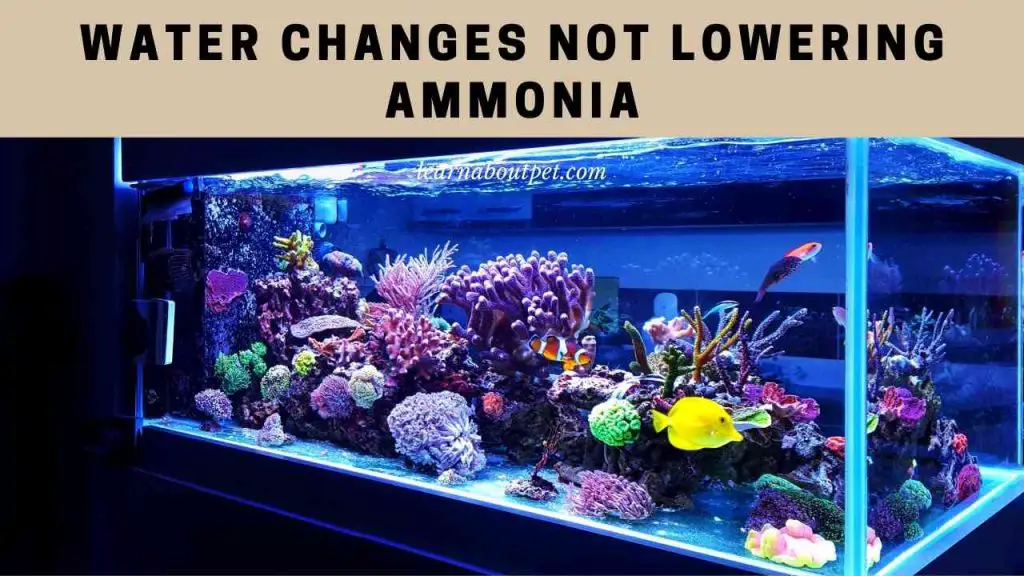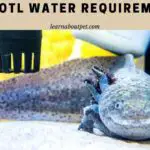It can be frustrating for an aquarium owner to be in a situation where water changes don’t lower ammonia levels. Faced with such a situation, one will want to know why the water changes are not resulting in lower ammonia levels, and what can be done to correct the situation. Read on, for answers.
What may be the reasons for water changes not lowering ammonia? This situation may be due to filters not working as they should, improper cycling, overstocking the tank (or overfeeding the tank’s inhabitants) or water changes that are too drastic.
All these are possible reasons why you may end up with high ammonia directly after water changes.

In fact, rather than making the ammonia levels lower, the water changes may be making them higher.
But once you figure out the reason behind high ammonia after water change, you can take the right measures to correct the situation.
Why Is My Ammonia Level Still High After Water Change?
One key possible reason for water changes not lowering ammonia may be in that you are not doing the water changes properly.
For instance, you may be getting out too much of the water at once. When you do this, you end up also getting out the bacteria that would otherwise help you in converting ammonia into nitrites and then into nitrates.
When you remove them, it means that there is nothing to convert the ammonia into nitrites and then onto nitrates. Thus the ammonia level readings remain high.
Another possible reason for ammonia levels not dropping aquarium owners often have to contend with is that of improper cycling.
The process of cycling brings in bacteria that convert ammonia into nitrites and then onto nitrates.
But proper cycling takes time. Most people are not patient enough to let it run its course. They introduce animals (fish, axolotls or whatever) before cycling is done.
The end result is where you end up with inadequate levels of bacteria to convert ammonia into those other things.
Once you are in this situation, you will always have water changes not lowering ammonia.
In fact, you may continue seeing high ammonia levels after doing multiple water changes.
If your filters don’t work as they should, then you may find your ammonia not dropping even after water changes.
It may be a case where, rather than helping remove ammonia, the filters actually increase it!
Another possible reason for ammonia rising after water change is overfeeding. If you are overfeeding your tank’s inhabitants, they may produce too much waste: which contains ammonia.
Or if your tank is overstocked, its inhabitants may produce too much waste: which contains ammonia.
All this will lead to water changes not lowering ammonia.
Do Water Changes Reduce Ammonia?
If you are facing a water changes not lowering ammonia situation, you may actually get to a point where you start wondering whether the water changes lower ammonia at all.
So, indeed, will water change lower ammonia? The answer is yes. Water changes can remove ammonia: but only if you do them right.
Doing the water changes right is, firstly, about ensuring that you don’t remove too much or too little water. Ideally, you should change 30% to 50% of the water in one go.
If you change less than 30% of the water, it may not have an effect. And if you change more than 50% of the water, you may end up taking out lots of the bacteria you need to convert ammonia into less harmful things.
Further, doing the water changes right is about undertaking them often enough.
For instance, at times, you may need daily water changes to lower ammonia well.
The filter cleaning you do in the course of the water changes also needs to be proper. It needs to be thorough enough to remove stuff you don’t need. But not so thorough as to remove the bacteria you need to lower ammonia.
Needless to say, you need to be sure that you are using the right type of water.
For instance, if you introduce ordinary tap water, you may end up with higher ammonia levels. In fact, you may end up with levels of ammonia too high, now cloudy tank.
That is because ordinary tap water itself usually contains a bit of ammonia.
Therefore if you introduce it into the tank, or just use it to clean the tank’s filters, the results can be bad.
How Many Water Changes To Lower Ammonia?
This, in other words, is a question on how many water changes to lower ammonia level in aquarium and get rid of it.
Much depends on the levels of ammonia you are trying to lower.
There are some instances in which a single water change is actually enough.
So you may be having an ammonia reading of, say, 0.25. Then after a single water change, it goes down to 0 – and that is it.
But there are other cases where you may need as many as 10 or even more water changes to lower ammonia.
For instance, you may be starting with an ammonia reading of 4. To get it to 0, you may even need a dozen water changes, if not more.
There are even cases where you may start giving up on the water changes, as a way to remove ammonia.
That is understandable, if you have a water changes not lowering ammonia situation.
It can get to a level where you start wanting to learn how to remove ammonia from water at home using chemicals.
Or where you set out to know how to reduce ammonia in axolotl tank quickly, without relying on water changes.
And this is where the various aquarium ammonia remover chemicals may come into the picture.
But in the final analysis, water changes can be effective at lowering ammonia. You just need to be patient enough to do the right number of water changes for your situation. And ensure that you are doing the water changes in the right way.

How Long Does It Take For Ammonia Levels To Drop?
There are several factors that will determine how long it takes for ammonia levels to drop.
Those include what the current ammonia levels are like, how far you want them to drop, and the method you are using to make them drop.
Suppose, for instance, your ammonia reading is at 3 and you want it to get to 0 mainly through the use of water changes.
This may call for a week of daily (30% to 50%) water changes.
And even then, you may face an ammonia levels won’t go down case, even after that much effort.
In fact, you may have the levels of ammonia rising after water change. So these are things you need to be ready for.
On the other hand, suppose your ammonia reading is now at 0.5. And you want it to get to at most 0.25, mainly using water changes.
This may be something you may manage to do in a day or two, with 30% to 50% water changes.
Now take another case, where you are using an aquarium ammonia remover chemical.
With this, you may get a lower ammonia reading in 24 to 48 hours. But the sustainability of it would be doubtful. That is because if you research on how often can you use ammonia remover in fish tank, you see that there are limits.
Yet another scenario: in the case of a new tank, using the cycling method, it could take 3 to 6 weeks for the ammonia levels to drop to a good level.
In the end, how long it takes for ammonia levels to drop depends on so many factors.
How Long After Water Change To Test Ammonia
Ideally, you need to allow some time for the new water to mix with the old water in the tank, before testing.
This is why most people recommend at least an hour. So you wait for at least an hour, before testing.
Otherwise if you test too soon, you may get improper readings. Then, for instance, you start wondering, why is my ammonia not going down? Yet it is you who is testing too soon after the water change.
Or, on the other end, testing too early may give an unbelievably high reading. Then you start asking, why did my ammonia level rise after a water change?
Yet it is you who is doing the testing too early on.
So it is best to allow the new water to mix with the old water. And about an hour should be enough for that.
Why Did My Ammonia Level Rise After Water Change?
The water changes not lowering ammonia levels situation is not the worst case.
You can actually have a situation where water changes make the ammonia levels to rise.
That is what may lead you to wonder why ammonia is higher after a partial water change.
One thing that can make ammonia levels rise after water change is a filter that doesn’t work as it should.
The filter in question may have gotten clogged up. Or it may be a filter that you cleaned using tap water, thus messing it up.
Another thing that can make ammonia levels rise after water change is use of the wrong type of water.
If, for instance, you introduce tap water (that often has ammonia), then the ammonia levels will only rise.
Yet another thing that can make ammonia levels rise after water change is overstocking in the aquarium. Or overfeeding the aquarium’s inhabitants.
Here, you end up with them producing waste that has a lot of ammonia, which reflects in the reading.
With time, it gets to a point where you move from saying ‘I cannot get my ammonia levels down with water changes’. You get to a level where the complaint is that the water changes are actually raising the ammonia levels.
If your tank wasn’t properly cycled, you can also end up with water changes not lowering ammonia – but actually increasing it.
And if you remove too much of the water at once (like more than 50%), you can also get into that situation. So you find water changes not lowering ammonia, but actually increasing it.
Ammonia Still High After A Water Change – What To Do?
The first thing to do is figure out what you may be getting wrong. So you ask yourself, why can’t I get rid of ammonia in aquarium with water changes?
Is it a case where your filters are not working properly? Is it a case where your tank wasn’t properly cycled? Or is it a case where you are changing too much water at once?
Could it be a scenario where there is overstocking (or overfeeding in the tank)? Or is it something to do with the water you are getting into the tank?
First find out the reason behind the water changes not lowering ammonia problem.
Secondly, take the right corrective steps.
This may be a matter of changing your filters, or the filter media as the case may be.
It may also be a matter of tackling any overstocking or overfeeding problem.
Further, it could be a matter of switching from water that has too high ammonia (say tap water). Switch to water that is ammonia-free (say, the special aquarium water).
Measures like introducing plants into the tank, so that they can make use of the ammonia also work well.
So do measures like putting the tank through mini cycles, even after the first main cycling process.
All in all, if I cannot get my ammonia levels down with water changes, these are the measures I would adopt.
Final Verdict – Water Changes Not Lowering Ammonia
There are many possible reasons for water changes not lowering ammonia levels.
The reasons may include things like improper cycling, improperly functioning filters, overstocking or overfeeding, changing too much water at once and using water that is already contaminated with ammonia.

Once you figure out the reason for water changes not lowering ammonia, and take the right corrective measures, the problem should get solved.
If everything fails, there is always the harder option of starting another aquarium ab initio. Then follow the right protocols from the get-go, including proper cycling, to avoid ever getting into this situation again.
As a pet lover, make sure to learn about pet more and give your pet fish and pet axolotl a good and comfortable life!

Welcome to Learn About Pet. My name is Rajkumar Ravichandran and I love all pets, travel, and amazing food. I write about my passion and personal experience caring for multiple pets in this blog! ❤️
Post Disclaimer
DISCLAIMER: THIS BLOG OR WEBSITE, "Learn About Pet", DOES NOT PROVIDE YOU WITH MEDICAL ADVICE AND IS NOT A SUBSTITUTE FOR MEDICAL ADVICE. ALWAYS GET IN TOUCH WITH YOUR PERSONAL VETERINARIAN AND USE INFORMATION HERE AS GENERAL ADVICE.
The information, including but not limited to, text, graphics, images and other material contained on this website are for informational purposes only. No material on this site is intended to be a substitute for professional veterinary advice, food recommendation, diagnosis, or treatment. Always seek the advice of your veterinarian or other qualified health care provider with any questions you may have regarding a medical condition or for pet food related questions.







